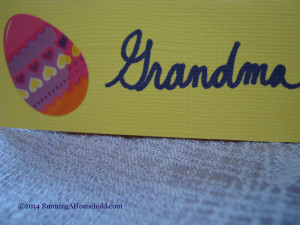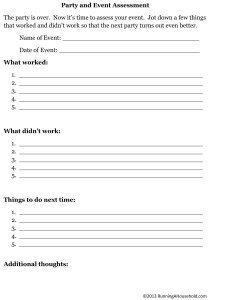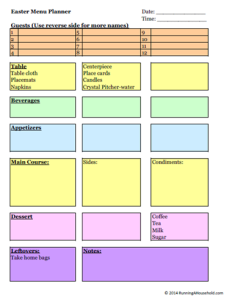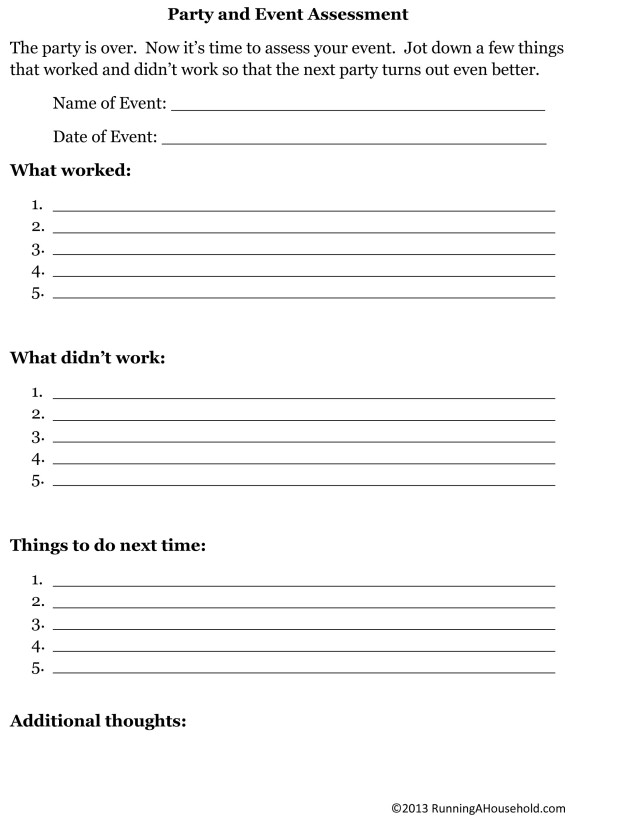Easter is officially over, and now it’s time to assess. Did everything go the way you planned? What changes can you make to improve for your next holiday? Use our Printable Party and Event Assessment Form to assess your Easter. Even if you didn’t host, take a minute to jot down a few ideas.
Why Assessing an Event is Important
We spend so much time planning and preparing for events. Chances are, if you hosted an event, you may host another one. By assessing your Easter, and all of the effort that went into planning the day, you can determine what worked and what didn’t work. This will make your next event more successful.
How to Assess Your Easter
Be sure to think about all of the phases of your dinner:
Planning: invitations, guests, date time
Meal: food, timing of appetizers
Set up: decorations, plates/napkins, flow of room
Here are some questions to ask yourself:
Were the right people invited? Too many people? Not enough?
Was there enough time for guests to talk and socialize?
Were you happy with the food preparation and selections?
How did the beverages work out? Did you have enough to serve?
Did the dessert work out well?
Assessing What Worked
Start with the positive items. Take a few minutes to think about what worked, and what you would do again next time. Here are a few examples of what really worked for our Easter dinner:
- Adding kielbasa to the Easter menu was a huge hit. We served sliced kielbasa on an appetizer platter along with horseradish cheese. It was delicious! We also made a hot appetizer with kielbasa in barbecue sauce. It was scrumptious!
- Starting our Easter event at 12:30. This gave us plenty of time in the morning to spend with our family and prepare food. We held our social hour from 12:30 – 1:30, and guests sat down to eat dinner at 1:30.
- Seating guests with place cards allowed everyone to take a seat quickly. It also meant that the hostess had easy access to the kitchen, and children were seated next to an adult who could help them cut their food.

- Bringing out the carrots and stuffing last: These dishes are tough to keep warm. We said grace, and started to pass the meat, gravy and dinner rolls clockwise around the table. While everyone was adding sour cream and butter to their baked potatoes, we brought out the carrots and stuffing. They came out piping hot, and didn’t cool off too soon.
- Asking guests to bring dessert. We followed our assessment from a previous year, and asked our guests to bring a dessert. Since we handled the appetizers and the main course, it was so nice not to worry about dessert. It even freed up some time on Saturday so we could handle other items, like simmering the kielbasa.
One memory we will always treasure about our 2017 Easter was reading bible stories to our children on Good Friday. They are at an age where they are curious and asking questions about God. We had some quiet time on Friday to read from the children’s bible and are so glad we did this.
What Didn’t Work
Even the best plans don’t always go off without a hitch. It’s important to identify and document the things that did not work. This will help you to improve the process for next time. Here are a few examples from our Easter:
- Planning for warm weather: This year, the weather was unseasonably warm. We needed to open the windows, but honestly could have turned on the air conditioner. Guests did not feel like eating as many appetizers or drinking as much wine. It was important to have extra ice on hand, since our guests drank lots of water. The weather even impacted the Easter egg hunt. We’ll be sure to avoid chocolate filled eggs on hot days!
- Having lots of desserts: For some reason we ended up with a lot of desserts. Some guests brought two desserts, and another brought a surprise dessert. Just glad we had enough room on our kitchen counter! It worked out fine, and we made up a goody bags for guests to take leftovers home.
Things to Do Next Time
A lot of preparation goes into making Easter a nice day. Do you wish you could have done something differently? Make a note so that next time, you’ll remember what to change. Here are a few examples from our Easter:
- Find a way to go to church on Sunday morning. When you host, this isn’t always possible. However, Easter is a religious celebration, and going to church on Easter Sunday is much more meaningful.
- Serve fewer appetizers: Everyone enjoyed the addition of kielbasa as an appetizer, but the fruit and veggie trays were hardly touched. We will need to reconsider how much food we put out next time. Maybe just a kielbasa and cheese tray, along with some fresh fruit would be enough.
- Suggest alternatives to candy. The Easter bunny brought chocolate and jelly beans. There was also an outdoor Easter egg hunt with even more candy. Relatives brought lots of chocolate bunnies and goodies. Instead, ask for books and non-edible treats.
It’s great to have the Easter holiday behind us so we can look forward to Spring and Summer. Overall it was a great day, and everyone enjoyed themselves. Now that we’ve assessed everything, we can make a few tweaks so that next year is even better. After all, if we keep doing the same thing, we can expect the same results.
Printable Party and Event Assessment Chart
Now it’s your turn to assess your day. Click on the link below and print a copy of our Party and Event Assessment Form:

Party and Event Assessment Chart
Jot down your thoughts so that next time, your event will be a little easier. 🙂
And just to make sure you are prepared, here are the dates for Easter for the next few years:
- April 1, 2018
- April 21, 2019
- April 12, 2020
- April 4, 2021
In case you missed it, here is the article with our printable Easter planning forms:

Hosting Easter? A Menu Planner, Cooking Timeline and Checklist You Can’t Miss

